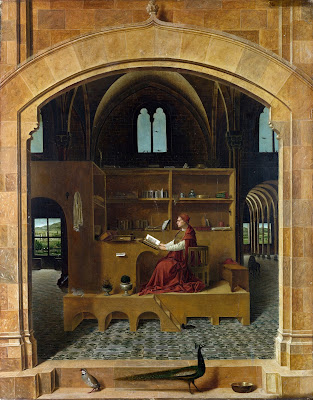ABOUT THIS BLOG: OBJECTIVES AND GUIDELINES
Essence of Films: Renaissance Paintings
 Being an audience means being in search of clues about our own life in the works of art that we look, be it a painting, a musical composition, a film or ballet. To become engaged in a work, we need to find things that reflect some parts of our lives in it. Renaissance paintings are known for their ability to draw the audience inside the painting, and make it possible to offer various interpretations.
Being an audience means being in search of clues about our own life in the works of art that we look, be it a painting, a musical composition, a film or ballet. To become engaged in a work, we need to find things that reflect some parts of our lives in it. Renaissance paintings are known for their ability to draw the audience inside the painting, and make it possible to offer various interpretations.
Antonello de Messina's painting "St. Jerome in His Study" is an example that presents many details from our everyday life; although the painting was completed hundreds of years ago, it reflects common details from the contemporary living. The flying birds seen through the windows, a little messiness on the table and the bookshelves, taken off slippers before the entrance, the symbolic lion which reminds us about our cats, and even the cracks on the walls and shelves contributes to the realistic effect the painting offers. Nevertheless, in my humble opinion, what makes this painting more engaging for us is the open door that frames the painting. Thanks to this open door, we feel like we have found a chance to have a glance over the other people's daily lives; it evokes wonder and gratitude, especially if the door opens up to a saint's life. This wonder and gratitude constitute the essence of the contemporary filmmaking and is why we fill the cinema halls. John David Rhodes believes that in both paintings and films"we can enter into a world and apprehend a world, if only with our eyes". He suggests that the essence of Renaissance Paintings and films are the same and the film industry takes Renaissance Paintings as an example in terms of engaging the audience by leaving them an 'open gate' or a chance for witnessing others' lives.
In my opinion, the reason for the engagement of the audience lies in the details. According to what Roland Barthes' theory l'effet de reel, we become engaged in the work because the little details make the work seem more real and like a part of our lives. Indeed, we cannot feel connection to any work if it is completely unfamiliar to us and simply too perfect to be realistic. This is the case with both Renaissance Paintings and films, as well. It is the Renaissance period in which the painters cracked the secrets of painting such as the effects of light and shadows, light glows on metallic surfaces, the sublime feeling created by the height and magnitude, all of which adds up to the realistic effect that draws the audience in for centuries, and is contemporarily used in the film industry.
 Being an audience means being in search of clues about our own life in the works of art that we look, be it a painting, a musical composition, a film or ballet. To become engaged in a work, we need to find things that reflect some parts of our lives in it. Renaissance paintings are known for their ability to draw the audience inside the painting, and make it possible to offer various interpretations.
Being an audience means being in search of clues about our own life in the works of art that we look, be it a painting, a musical composition, a film or ballet. To become engaged in a work, we need to find things that reflect some parts of our lives in it. Renaissance paintings are known for their ability to draw the audience inside the painting, and make it possible to offer various interpretations.
Before starting, thank you for your informative essay. First of all, I would like to criticize your essay in terms of its structure and content, and then my own reflections about the topic.
ReplyDeleteIn my opinion, structure of your essay is great because at the beginning part you prepare readers with your descriptive sentences to the essay. Also while reading, it was clear that what you are going to be talking about and it makes your essay easy to follow. Besides, you effectively argued about your topic by giving examples from painting and quote from other reviewer. However, although you support Alberti's ideas about usage of light, shadow and proportions; you didn't mention his thoughts directly. I think, it would have been great if you had quoted from him because it was overall aim of the essay, if I am not mistaken.
About the content of your essay, the connection that you made between film industry and Renaissance paintings was impressing and I really felt that way when I look at it. Also the open door idea is really like we have an access to their world.
Although I agree with you at this point, I think we search clues about our lives not because they are real, but because they are ideal and beautiful. For instance, as a real life example I watch movies to take me into another ideal world and make me forget my imperfect, boring , real life problems. Also, Alberti says that painters aim is to observe nature and collect the best ones from many (p.88). Moreover, he claims that the important thing is not likeness, it is its beauty as a Renaissance painter(p.89).